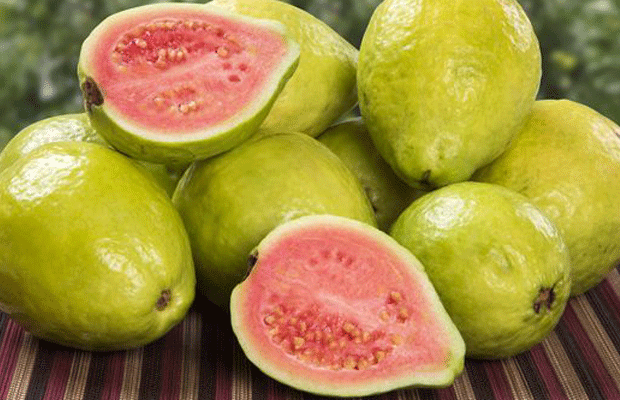https://cdn.steemitimages.com/DQmU7xftKVPZCyuRL8JuS975jyZVbb9K4xFD8Umo81Pf4Q1/guayabas-6.gif
[source](https://www.google.co.ve/url?sa=i&source=images&cd=&cad=rja&uact=8&ved=2ahUKEwirpMS_i_TiAhVIAqwKHQHCCMkQjRx6BAgBEAU&url=%2Furl%3Fsa%3Di%26source%3Dimages%26cd%3D%26ved%3D%26url%3Dhttp%253A%252F%252Fwww.televen.com%252Felnoticiero%252Fconoce-todos-los-beneficios-consumir-guayabas-regularmente%252F%26psig%3DAOvVaw1Bnd6B3gStNVxpcTVOlXXr%26ust%3D1560983658027921&psig=AOvVaw1Bnd6B3gStNVxpcTVOlXXr&ust=1560983658027921)

The guava, a small evergreen tree up to 3-4 m high, belongs to the myrtle family and tolerates drought well. It blooms once or twice a year. It gives a main crop: up to 100 kg per tree and 2-4 additional crops, considerably smaller. The guava ripens ninety and one hundred and fifty days after flowering. The shape and size of the fruit is extremely variable. The guava looks like a green or yellow apple. The fruits are round and pear-shaped, with a thin skin of bright yellow, reddish or green. The weight of the fruit of the cultivated varieties is from 70 to 160 g, the length of the fruit is from 4 to 6,5 cm, diameter: from 4,8 to 7,2 cm. Due to the content of hexahydroxydiphenic acid and arabinose ester, immature fruits have a very acid taste, which disappears in mature fruits. Guayaba homeland - South and Central America, probably Peru. In any case, the Spaniards found it in Peru and Colombia and extended it throughout most of the tropical zone. Guava is common in tropical and some subtropical regions of Asia, Africa, South America and the Nort Guava contains many vitamins A, B and especially C, up to 10 times more compared to citrus fruits (240 mg per 100 grams), so its use is recommended to strengthen the lymphatic system and raise the overall tone in the body . Guava is very rich in fiber, proteins and fats, calcium, phosphorus and iron. According to European nutritionists, guava is a wonderful, important and absolutely indispensable element that underlies baby food and the diet of pregnant women, a product that strengthens the immune system and perfectly restores strength. Guava has astringent, bactericidal and antispasmodic effects. It is used together with bones or in the form of cut, like apples. The ripe guava can be eaten with the skin (it is thin, but with a bitter taste). Improves digestion, stimulates the heart and normalizes blood pressure. This is the only fruit in the world in which the content of vitamin C is several times greater than that of oranges. Therefore, guava fruit is recommended to strengthen the body's lymphatic system and increase its overall tone. In the islands of the West Indies, guava fruits are eaten against seizures and epileptic seizures, in Brazil for diarrhea, in the Philippines for heart disease, in Panama against bronchitis, asthma, sore throat and lungs, and in Israel simply because they prefer Tasty healthy food Guana leaf tea helps with stomach upsets, dysentery and dizziness, and also regulates menstrual cycles. The crushed guava leaves are applied to fresh and tearing wounds. They also chew with toothache. A decoction of the leaves is used as a means to cough, to gargle, as well as diseases of the oral cavity. The broth is used as an antipyretic agent and for skin diseases. The ripe guava has a pleasant and very strong smell. If you take a guava to a room full of smoke, its smell will deaden the smell of tobacco. Guava produces excellent jams and jellies, due to the high content of pectin in the fruit, as well as juices, salads, jellies, syrups, mashed potatoes and pasta, similar to quince. The guava can be preserved, made of fruit, butter, jam, cakes, tomato sauce or chutney. Guava jelly, which can be spread on bread or served with venison or roast pork, is delicious and healthy. Jelly is very easy to prepare: it requires fruit, lemon juice and sugar. You can also use guava instead of apples that do not grow in Thailand, and make it a great mashed potatoes, cooked fruit and pie filling. The guava is ideal for preparing baking dressings. The jam is prepared from the guava fruits. Guava is used in ice cream. The fruits are added to the waffles, puddings, smoothies. Due to its sugar, guava is combined with sweet and bittersweet fruits, as well as with all dairy products. Excessive consumption of guava (more than 1 kg at a time) can cause indigestion. People who are prone to allergies should use guava carefully. In addition, it is impossible to eat the immature fruits of the guava for those who are prone to the formation of kidney stones.

Originally posted here: https://steemit.com/naturalmedicine/@rosmarycar91/the-guava-and-its-benefits


No comments:
Post a Comment